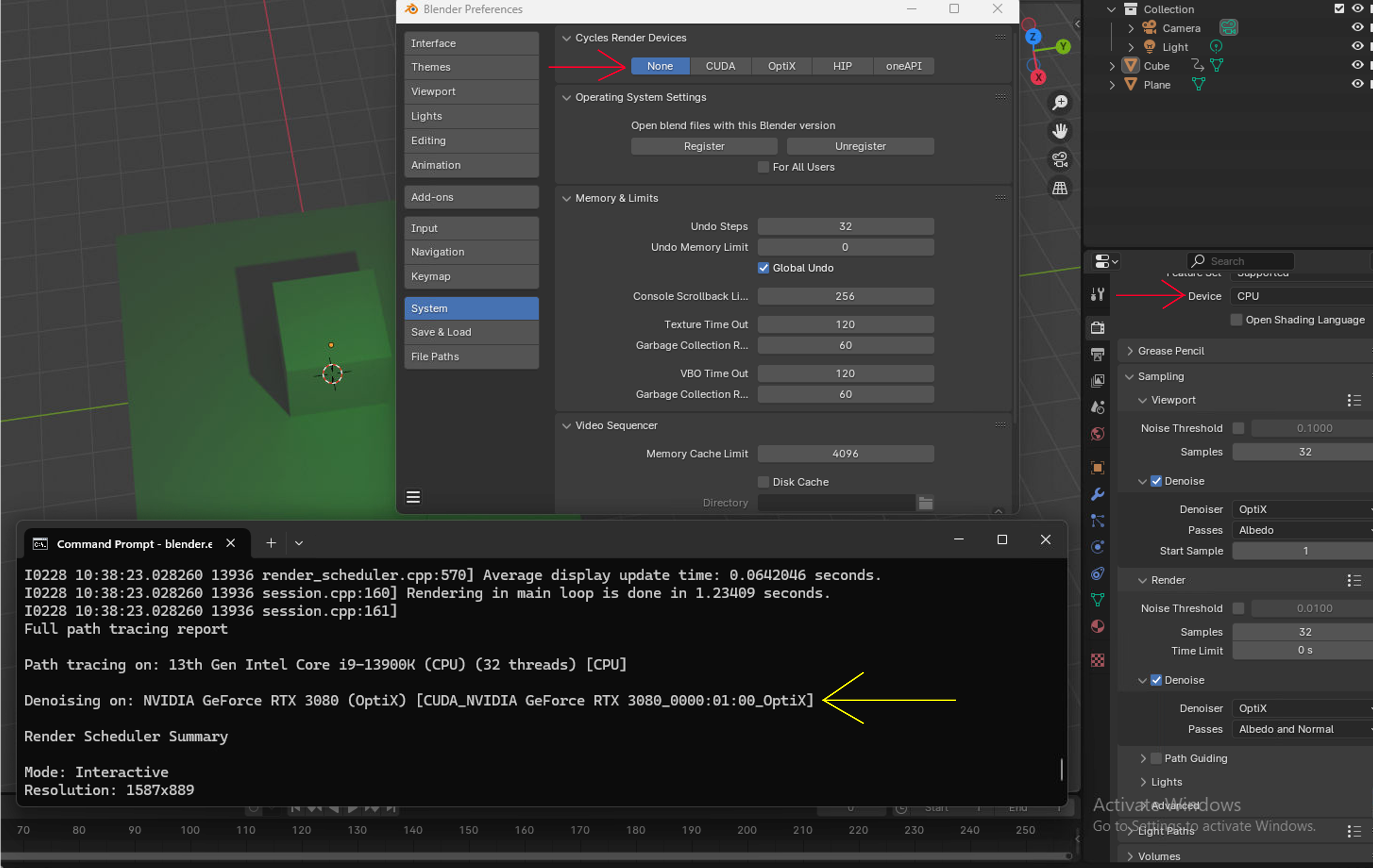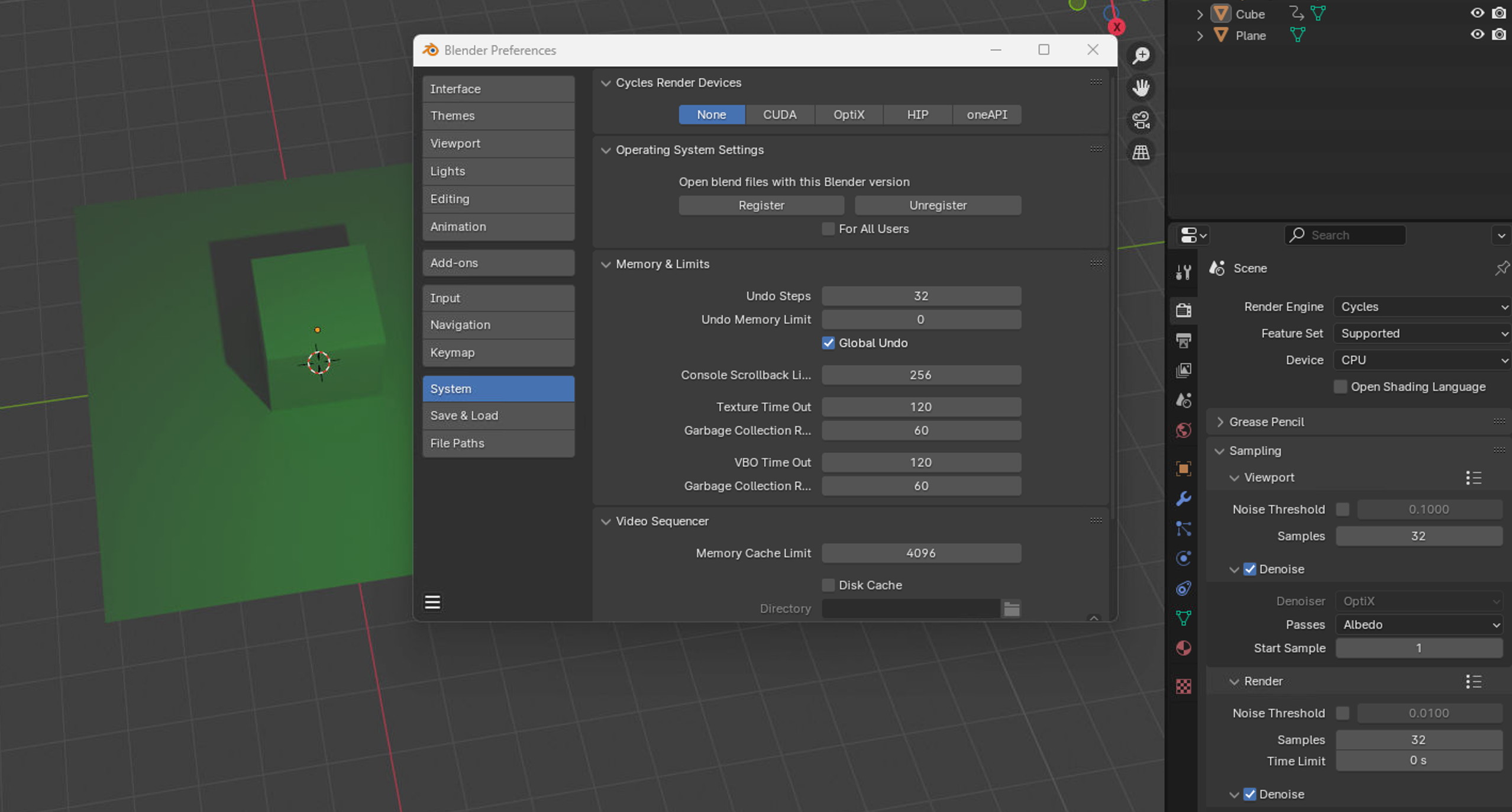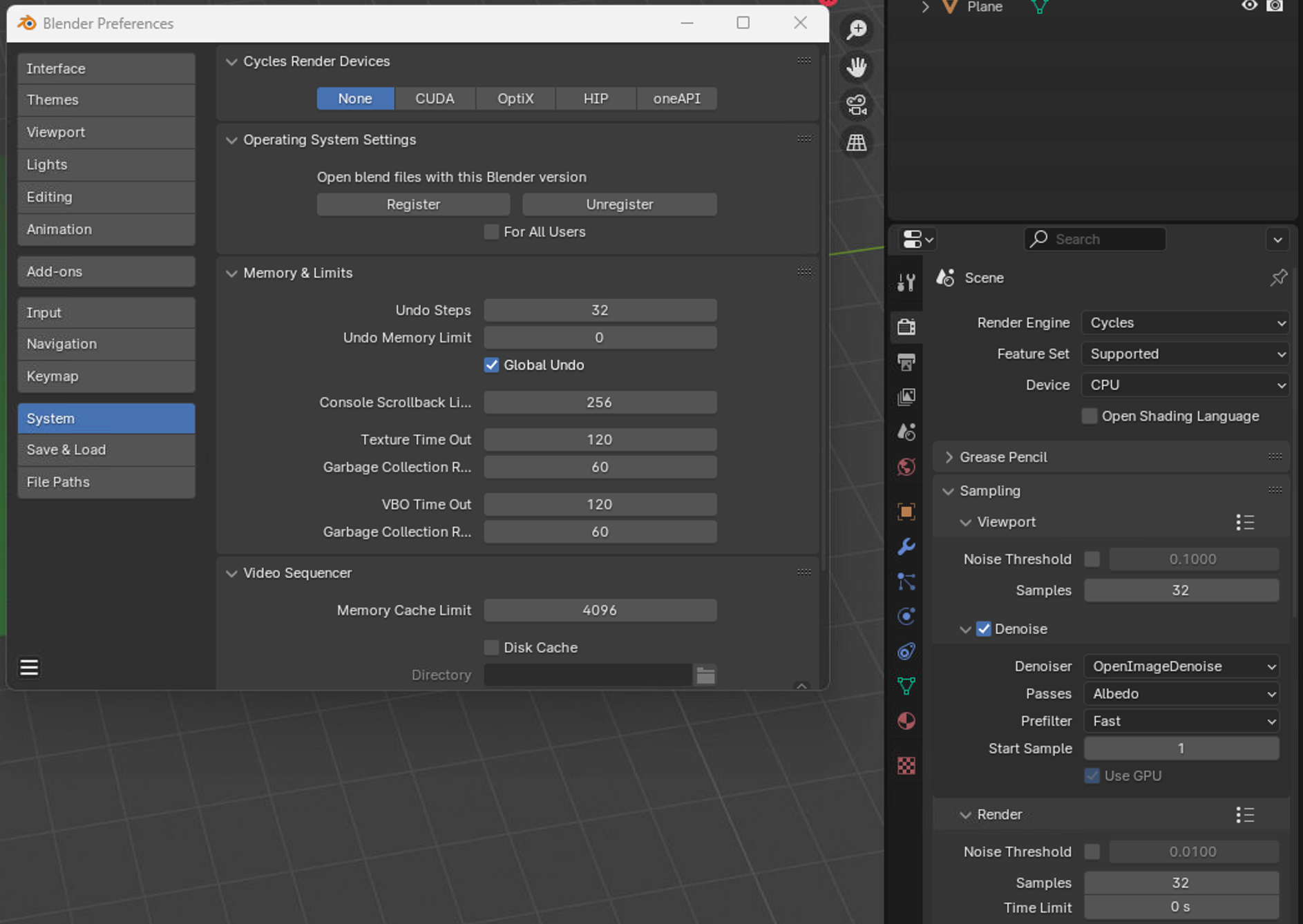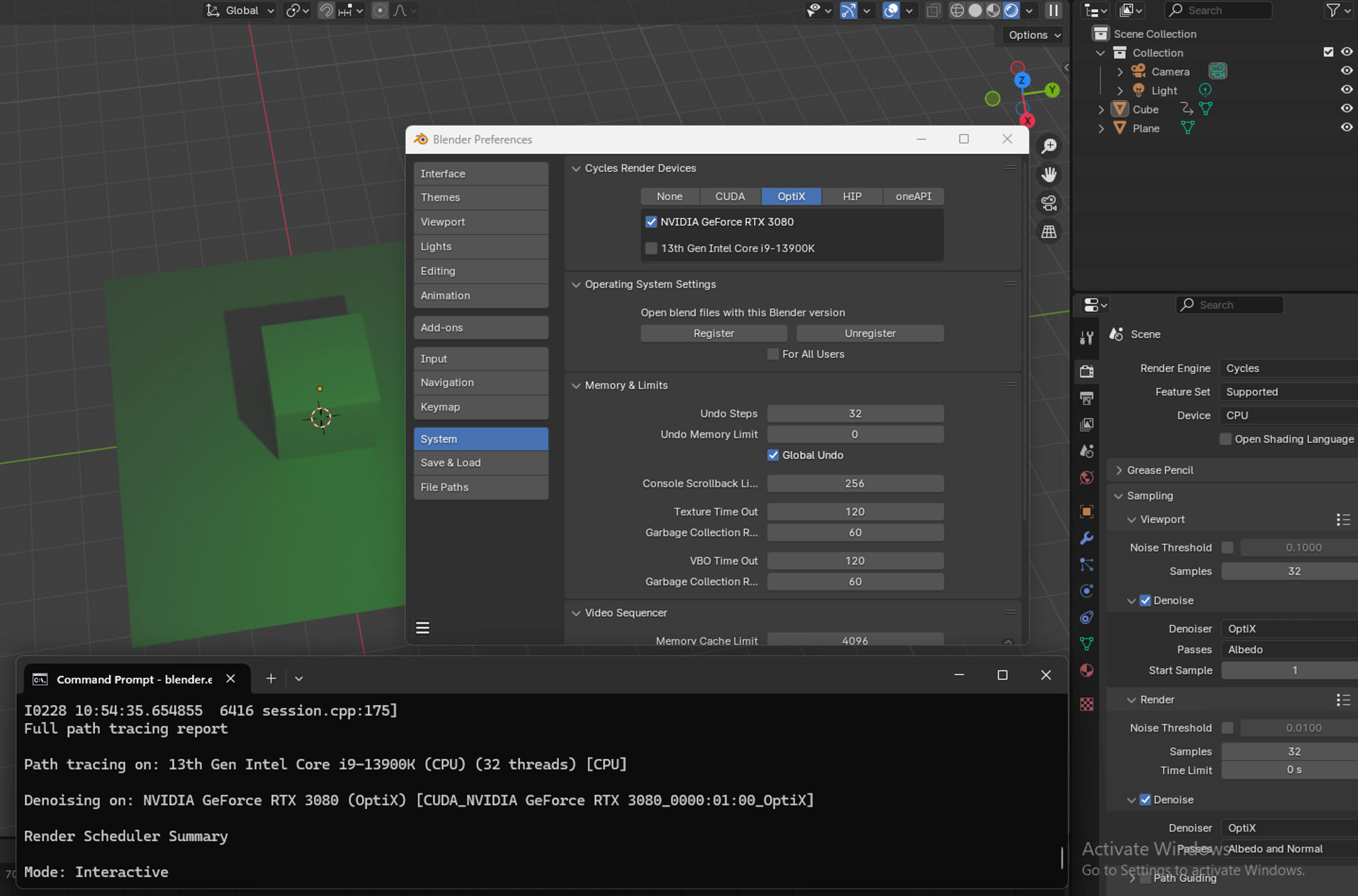WIP: Fix: Respect Blender Cycles setting for GPU denoising #118841
No reviewers
Labels
No Label
Interest
Alembic
Interest
Animation & Rigging
Interest
Asset Browser
Interest
Asset Browser Project Overview
Interest
Audio
Interest
Automated Testing
Interest
Blender Asset Bundle
Interest
BlendFile
Interest
Collada
Interest
Compatibility
Interest
Compositing
Interest
Core
Interest
Cycles
Interest
Dependency Graph
Interest
Development Management
Interest
EEVEE
Interest
EEVEE & Viewport
Interest
Freestyle
Interest
Geometry Nodes
Interest
Grease Pencil
Interest
ID Management
Interest
Images & Movies
Interest
Import Export
Interest
Line Art
Interest
Masking
Interest
Metal
Interest
Modeling
Interest
Modifiers
Interest
Motion Tracking
Interest
Nodes & Physics
Interest
OpenGL
Interest
Overlay
Interest
Overrides
Interest
Performance
Interest
Physics
Interest
Pipeline, Assets & IO
Interest
Platforms, Builds & Tests
Interest
Python API
Interest
Render & Cycles
Interest
Render Pipeline
Interest
Sculpt, Paint & Texture
Interest
Text Editor
Interest
Translations
Interest
Triaging
Interest
Undo
Interest
USD
Interest
User Interface
Interest
UV Editing
Interest
VFX & Video
Interest
Video Sequencer
Interest
Virtual Reality
Interest
Vulkan
Interest
Wayland
Interest
Workbench
Interest: X11
Legacy
Blender 2.8 Project
Legacy
Milestone 1: Basic, Local Asset Browser
Legacy
OpenGL Error
Meta
Good First Issue
Meta
Papercut
Meta
Retrospective
Meta
Security
Module
Animation & Rigging
Module
Core
Module
Development Management
Module
EEVEE & Viewport
Module
Grease Pencil
Module
Modeling
Module
Nodes & Physics
Module
Pipeline, Assets & IO
Module
Platforms, Builds & Tests
Module
Python API
Module
Render & Cycles
Module
Sculpt, Paint & Texture
Module
Triaging
Module
User Interface
Module
VFX & Video
Platform
FreeBSD
Platform
Linux
Platform
macOS
Platform
Windows
Priority
High
Priority
Low
Priority
Normal
Priority
Unbreak Now!
Status
Archived
Status
Confirmed
Status
Duplicate
Status
Needs Info from Developers
Status
Needs Information from User
Status
Needs Triage
Status
Resolved
Type
Bug
Type
Design
Type
Known Issue
Type
Patch
Type
Report
Type
To Do
No Milestone
No project
No Assignees
2 Participants
Notifications
Due Date
No due date set.
Dependencies
No dependencies set.
Reference: blender/blender#118841
Loading…
Reference in New Issue
No description provided.
Delete Branch "Sirgienko/blender:address_gpu_denoising_settings_respect"
Deleting a branch is permanent. Although the deleted branch may continue to exist for a short time before it actually gets removed, it CANNOT be undone in most cases. Continue?
Previously, GPU denoisers were ignoring settings about render
configuration and were using any available GPU. With these changes,
GPU denoisers will use the device selected in Blender Cycles
settings.
This allows any GPU denoiser to be used with CPU rendering.
@brecht Can you please take a look on this solution? It is about respecting Blender setting for GPU denoising device selection (both OptiX and OIDN). I think it make sense to get this fix to clarify UX for the users, but the patch is not small, so I would understand if you would want this to be postponed for 4.2.
Also, I could actually address this behavior with more easy to implement approach that "Device" UI option, which is defining device used for render, should affect denoising device as well - but then it would be not possible to use GPU denoising during CPU render, which may be not very popular configuration, but I would expected that some people may use it so it wouldn't be nice to remove this functionality even if wasn't intended initially.
A clarification about how it is working right now and how it suppose to work with this change.



Current behavior - despite Cycles preference (red arrows), denoising is happening (yellow arrow) on first found GPU device:
Behaviour with this changes - if None or CPU devices or GPU devices, which are not supporting GPU denoising are selected in the Cycles preferences, then GPU denoising options (Optix denoiser and "Use GPU" OIDN option) will be grayout out and won't be applied, as denoising will happen on CPU:
And when GPU devices, which is supporting GPU denoising, is selected in the Cycles preferences, then this GPU denoising options won't be grayed out and will apply according to the selection:

So in a nutshell: Right now there are a per-scene denoisers configuration options, which are not aligned with user's Cycles preferences and not respecting them. With this change, it will be addressed and GPU denoising device selection will work in the same approach as "Device: GPU compute" is working right now - preferences will determine which device will be used and if compatible device is not selected, then the UI option will be grayed out and CPU fallback will be used.
ffb4f5bdf6to07968d7e0e07968d7e0eto83b084ab3dThis seems too risky this close to the release, it's hard to get this properly user tested in such a short time. Particularly the support for CPU rendering I would rather postpone. If there is a bugfix we can consider it, but hopefully the change is simpler then.
This adds a denoise device in
Session, but there already exists alocal_denoiser_device_inDenoiser. Isn't it possible to use that instead?The way I understand the code in
Denoiser::ensure_denoiser_devicenow, is that it will already try to use one of the path tracing devices for denoising. So in that sense it respects the choice of GPUs, except if you happen to be path tracing with a GPU that doesn't support OIDN and have another GPU that does. We could change the logic so it doesn't do that, but it seems a pretty rare corner case.Understandable, and unfortunately this is the easiest solution which I have found so far, so I suppose it will be indeed change for the 4.2 LST, I will update milestone information accordingly.
No, I don't think that is possible to use only local_denoiser_device_, because
Denoiserclass is not taking into account Blender preferences and Scene settings when determining the local_denoiser_device ("Denoiser device created to perform denoising when none of the rendering devices are capable of denoising."). This is because the Denoiser class does not have access to these settings, as only few Blender Cycles classes and functions are having it - intern/cycles/blender/session.cpp and intern/cycles/blender/python.cpp, in particular.However, the
Sessionclass does have indirect access to preference information, as this data is passed in the form of aSessionParamsstruct to theSessionconstructor. And the class responsible for creating theSessionobject is expected to populate the SessionParams structure with the appropriate information based on the Preferences and Scene settings. This for example how it is done in theBlenderSession::create_session()method and in theBlenderSync::get_session_paramsmethod, which constructs the SessionParams structure.Essentially, once denoising is allowed on devices that differ from the path tracing devices, we should employ the same method used for path trace devices to ensure reasonable UI/UX behavior. The denoising devices should be determined based on the Cycles preferences and Scene settings by a class that has access to both. Then this information in a form of
DeviceInfoshould be passed through various Cycles classes, until it will reach the relevant class (in this case a class aboveDenoiserdue to memory management approach). The relevant class then will create a Device object from this information and thenDenoiserwill utilize thisDeviceobject for computations.Approach
it will already try to use one of the path tracing devices for denoisingis leading to the situation, that we could easily use GPU denoising with GPU path tracing and CPU denoising with CPU path tracing. But as soon as we want to have CPU render and GPU denoising -ensure_denoiser_devicewill work in quite strange way, in my opinion.For example, for OIDN,
ensure_denoiser_devicewill never able to find GPU device for denoising when path tracing is happening on CPU - because path tracing CPU device will be checked first inensure_denoiser_device, and CPU device (almost always) is supporting OIDN denoiser, so no futher search will be conducted.For the OptiX denoiser, this is not an issue because OptiX is not supported on CPU. However, there is still an uncontrollable aspect regarding which NVIDIA device will be used for GPU denoising when path tracing is happening on CPU. As I see, the code in "find_best_device" prefers an NVIDIA GPU which is connected to a display. This may be acceptable for the Blender's user, but if they prefer otherwise, then there is currently no way to control this behavior. Because the selection of an NVIDIA GPU is hardcoded in the source code.
And, as I have mentioned above,
Denoiserclass do not have access to the Cycles preference and Scene settings, so this information can't be used inensure_denoiser_device- as I see, this is a reason why user have so little control overensure_denoiser_devicebehaviour.Another issue, in my view, is that we never actually use the
Denoiser::ensure_denoiser_devicemethod directly; instead, it is called from its subclasses, such asOptiXDenoiser,OIDNDenoiser, andOIDNDenoiserGPU. In these instances, we have already partially determined the device we intend to use for denoising—if we create anOptiXDenoiserobject, for example, it implies we wantOptiXdenoising on an NVIDIA GPU. Therefore, I believe that ideally, we should not have theensure_denoiser_devicemethod at all. The decision on which device to use for denoising should be made at the same level where we decide which denoiser subclass to instantiate.I think we should not have both
local_denoiser_device_inDenoiser, anddenoise_deviceinSession, it should be one or the other. So if this denoiser device is added at the Session level, that should then fully replace the denoiser device detection and creation at the Denoiser level.It's hard for me to guess which way leads to the simplest implementation. But I'm guessing it's best to remove a bit of abstraction in Denoiser, and make
Denoiser::createresponsible for creating the denoiser device before theDenoiserinstance. That way the logic does not get spread out to the Session, and the confusing flow with subclasses creating the device is avoided.Fix: Respect Blender Cycles setting for GPU denoisingto WIP: Fix: Respect Blender Cycles setting for GPU denoisingCheckout
From your project repository, check out a new branch and test the changes.